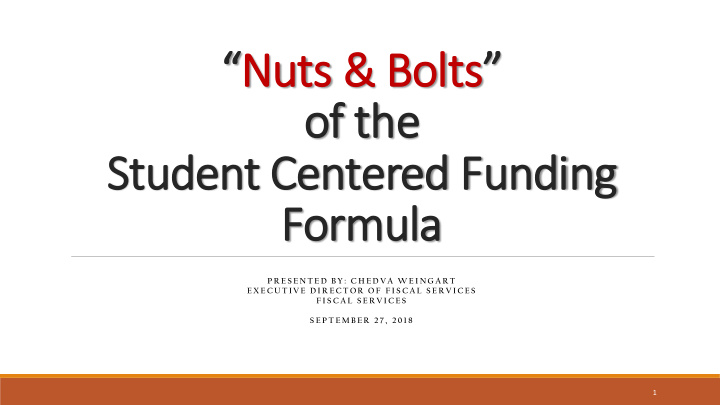



“Nut uts & & Bol olts” ” of of t the he Stud uden ent C Cen entered ed Fun unding g Formula la P R E S E N T E D B Y : C H E D V A W E I N G A R T E X E C U T I V E D I R E C T O R O F F I S C A L S E R V I C E S F I S C A L S E R V I C E S S E P T E M B E R 2 7 , 2 0 1 8 1
Current Challenges While the system has made significant strides in improving student success, serious challenges remain. ◦ Most students who enter a community college never complete a degree or certificate or transfer. ◦ Students who do reach an educational goal take a long time to do so. ◦ Achievement gaps persist (across student groups and across regions). Discussions about a new funding formula began more than a year ago, given concerns among system stakeholders that enrollment—the traditional driver of funding—has been stagnant in many districts. 2
Principles for Reform In reforming funding for community college districts, we aim to do the following: ◦ Encourage progress toward the Vision for Success adopted by the Board of Governors. ◦ Provide groups of students that have faced barriers to success with additional support to meet our goals. ◦ Make resources most useful to community college districts by making them stable, predictable, and flexible. We want community college finance to further the activities the Chancellor’s Office is undertaking through the Guided Pathways framework 3
Student Centered Funding Formula The new formula calculates apportionments generally using three allocations: ◦ Base Allocation— Current factors (primarily credit FTES). ◦ Supplemental Allocation— Counts of low-income students. ◦ Student Success Allocation— Counts of outcomes related to the Vision for Success , with “premiums” for outcomes of low-income students. FTES for noncredit courses, and FTES for “special admits” (high school students) and incarcerated students, would be funded at current rates. The rates are calculated to provide a three-year transition. 4
Base Allocation Credit FTES The 2018-19 rate is $3,727. Base equals three-year average of Current Year, Prior Year, and Prior, Prior Year. Current Year will include any restoration of prior year declines. Growth will be calculated from this three-year average base. Noncredit FTES The 2018-19 rate is $3,347. Funding rate remains unchanged from current funding rate. Growth will be calculated from Prior Year FTES, adding any restoration that occurs. Career Development College Preparation (CDCP) FTES The 2018-19 rate is $5,457. Funding rate remains unchanged from current funding rate. Growth will be calculated from Prior Year FTES, adding restoration that occurs. 5
Base Allocation Inmates in Correctional Facilities Credit FTES The 2018-19 rate is $5,457. Funding rate remains unchanged from current funding rate for this population of students. This workload measure will be identified on new apportionment reports. Inmates in Correctional Facilities Noncredit FTES The 2018-19 rate is $3,347. Funding rate remains unchanged from current funding rate for this population of students. This workload measure will be identified on new apportionment reports. Special Admit Credit FTES The 2018-19 rate is $5,457. Funding rate remains unchanged from current funding rate for this population of students. This workload measure will be identified on new apportionment reports. 6
Supplemental Allocation Three Elements 1. Pell Grant recipient counts 2. California College Promise Grant recipient counts (BOG fee waiver recipients) 3. AB 540 student counts The 2018-19 rate is $919 per count. Counts are from the prior year. Counts will be updated in fall of the current year to determine funding in the budget year. 7
Student Success Allocation Associate Degrees for Transfer (ADT) Note: Count of all ADTs by district, with point assigned to district granting degree. No minimum unit requirement for student to be counted. 8
Student Success Allocation Associate Degree & Baccalaureate Degrees • Note: Count of all associate degrees by district, with point assigned to district granting degree. No minimum unit requirement for student to be counted. • Note: Count of all Baccalaureate Degrees by district, with point assigned to district granting degree. No minimum unit requirement for student to be counted. 9
Student Success Allocation Credit Certificates (16 units or more) Note: Count of all credit certificates by district, with point assigned to district granting certificate. No minimum unit requirement for student to be counted. 10
Student Success Allocation Completion of Transfer-Level Mathematics and English Courses within First Academic Year of Enrollment MIS special data run. Completion of both math and English in the same academic year (summer, fall, winter, spring). 11
Student Success Allocation Successful Transfer to Four-Year University Chancellor’s Office MIS special data run. Students must have 12 or more units at a community college to count. Direct match with CSU, UC and Clearinghouse . 12
Student Success Allocation Completion of Nine or More CTE Units Note: MIS special data run . 13
Student Success Allocation Attainment of Regional Living Wage Chancellor’s Office MIS special data run. Count of students enrolled in 2015 -16 and then attained their county living wage in 2016-17. 14
Question ons ? 15
Recommend
More recommend